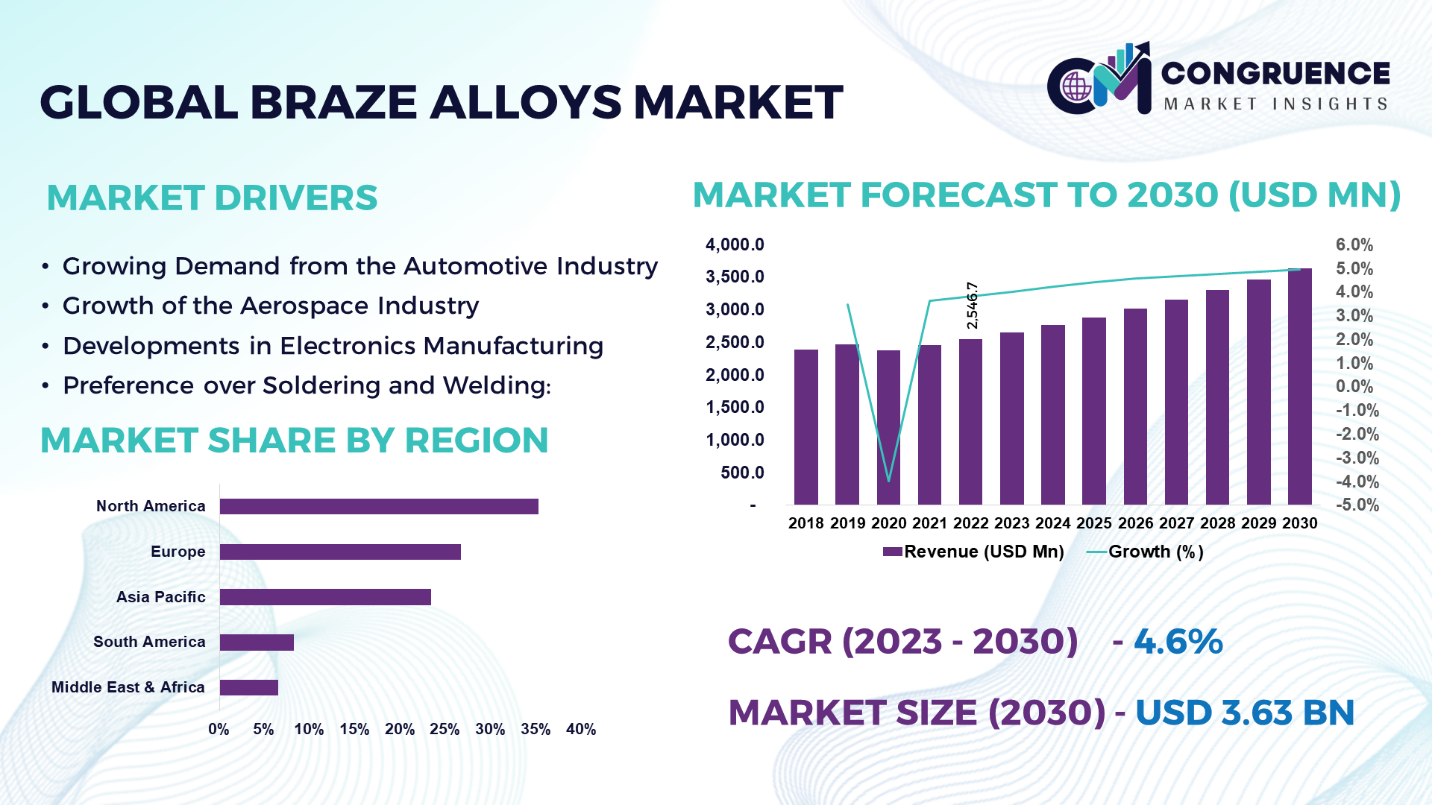Reports
The Global Braze Alloys Market was valued at USD 2,546.7 Million in 2022 and is anticipated to reach a value of USD 3,634.5 Million by 2030 expanding at a CAGR of 4.6% between 2023 and 2030.
A brazing alloy is a filler metal that, when heated, melts and liquefies to fill the space between two tightly fitting components and create a brazed junction. In appropriately prepared joints, capillary attraction can be used for distribution when a brazing alloy possesses the right melting and flow characteristics. Brazing alloys result in joints with strength and corrosion resistance that satisfy service requirements. Tin, silver, copper, aluminum, nickel, cadmium-free, silver-phos, and jeweler’s gold are examples of common brazing alloys. Brazing alloys are available in powder, paste, slugs, washers, rings, and wire forms in solid form. Brazing is the process of connecting two or more metals together by melting them and then filling the joint with another metal that has melted. The braze alloy, also known as the filler metal, lowers the melting point of the primary metals used in brazing. The melting point of a braze alloy is often higher than 450°C. The temperature shouldn't, however, exceed the melting point of the relevant base metals. Braze alloys can be used as paste, foil, powder, braze wires, rods, and tapes, among other forms. The increasing use of braze alloys for a variety of applications across several end-user sectors is responsible for the market's demand and popularity for these materials worldwide.

Braze Alloys Market Major Driving Forces
Growing Demand from the Automotive Industry: Heat exchangers, radiator tanks, and exhaust systems are among the numerous uses for which the automobile sector is a key user of braze alloys. The use of brazing methods is growing as a result of rising automobile manufacturing and the need for lightweight, energy-efficient designs.
Growth of the Aerospace Industry: To guarantee the effectiveness and security of airplane parts, the aviation sector requires superior materials and dependable connecting procedures. Braze alloys are widely used in aerospace applications, such as thermal protection, fuel nozzles, and turbine blades, which propels market expansion.
Developments in Electronics Manufacturing: As the electronics sector expands quickly, there is a growing need for braze alloys for circuit boards, electrical connections, and microelectronic devices. The requirement for effective heat dissipation and the shrinking of electronic components are driving the use of brazing techniques.
Preference over Soldering and Welding: The growing preference for brazing over soldering, welding, etc. for joining metals in a variety of end-user sectors worldwide is expected to be the primary growth driver of the global braze alloys market in the future. A few benefits of brazing include its low cost, ductility, self-fluxing nature, high electrical conductivity, and capacity to combine metals with a variety of components.
Braze Alloys Market Key Opportunities
Growing Emphasis on Sustainable Solutions: The development of eco-friendly braze alloys is made possible by the move toward environmentally friendly manufacturing methods and sustainable manufacturing. Manufacturers might investigate alternative brazing methods and the use of renewable materials to meet the growing demand for environmentally friendly products.
Rising Research and Development Expenditure: Leading Industry Players' sustained investment in R&D can result in the creation of sophisticated braze alloys with enhanced characteristics. Advancements in brazing methods and materials will increase market potential and provide access to new application areas.
Electronic and Electrical Component: In the electronics sector, braze alloys are employed in the assembly of parts such as sensors, connections, and microelectronic devices. Braze alloys providing accurate and dependable joining at small scales are becoming more and more necessary as electronic components get smaller.
Braze Alloys Market Key Trends
· Improvements in brazing procedures are a result of ongoing research and development, which raises the joining process's dependability and efficiency. Innovations such as laser and vacuum brazing are becoming more popular in a variety of sectors.
· Eco-friendly and sustainable braze alloys are becoming more and more in demand as environmental concerns rise. The goal of manufacturers is to create alloys with less of an adverse effect on the environment without sacrificing functionality.
· End-user industries are looking for braze alloys that are specifically suited to fulfill their needs. To meet these needs, manufacturers are making investments in cutting-edge production methods and providing customized solutions.
· The need for lightweight braze alloys is being driven by the expanding demand for lightweight materials in sectors such as aerospace and automotive. The goal of manufacturers is to create alloys that are lighter in weight without sacrificing strength or functionality.
· Automation and robotics integration into the brazing process is becoming more and more popular. Automated brazing systems guarantee accurate and consistent brazing outcomes while increasing productivity and lowering labor expenses.
Region-wise Market Insights
North America accounted for the largest market share at 35.2% in 2022 whereas, Asia Pacific is expected to register the fastest growth, expanding at a CAGR of 5.1% between 2023 and 2030.

The aerospace and automotive industries are the main drivers of the North American market. The region's strong R&D capabilities and emphasis on technological breakthroughs support market growth. Braze alloy demand is fueled by Europe's well-established automotive and aerospace industries. Additionally, the region places a strong emphasis on environmentally friendly braze alloy development through sustainable production methods. Asia Pacific presents a profitable market for braze alloys due to its rapid industrialization, improvement of infrastructure, and the existence of important electronics and automotive production hubs. The rise of the regional market is mostly due to the contributions of nations such as China, Japan, and India. The construction and automobile industries are the main drivers of the Latin American market's consistent expansion. The region's need for braze alloys is boosted by the rising demand for automobiles and infrastructure projects. Construction, automotive, oil and gas, and other industries are growing significantly across the Middle East and Africa. These industries' requirement for dependable and effective metal joining methods fuels the market for braze alloys.
Market Competition Landscape
The fierce competition among numerous manufacturers in the worldwide braze alloys market is a defining feature. Important companies in the braze alloys industry use tactics to get an advantage over their rivals. In order to adapt to changing consumer tastes, these methods include product innovation, design distinction, and the use of eco-friendly and sustainable materials. Established companies rely on their quality and dependability reputation to hold onto market share, while more recent competitors concentrate on disruptive technologies and USPs.
Prominent entities in the worldwide braze alloys industry employ diverse organic and inorganic tactics to fortify and enhance their market standing. Prominent players in the market include:
· Lucas-Milhaupt, Inc.
· Johnson Matthey
· Voestalpine Böhler Welding
· Morgan Advanced Materials
· Umicore
· Wall Colmonoy Corporation
· Fusion, Inc.
· Stella Welding Alloys
· Harris Products Group
· Aufhauser Corporation
· Sentes-BIR
· Lucasmilhaupt-Handy & Harman Ltd.
· Prince & Izant Company
· Indium Corporation
· Aufhauser Corporation (Select-Arc, Inc.)
|
Report Attribute/Metric |
Details |
|
Market Revenue in 2022 |
USD 2,546.7 Million |
|
Market Revenue in 2030 |
USD 3,634.5 Million |
|
CAGR (2023 – 2030) |
4.6% |
|
Base Year |
2022 |
|
Forecast Period |
2023 – 2030 |
|
Historical Data |
2018 to 2022 |
|
Forecast Unit |
Value (US$ Mn) |
|
Key Report Deliverable |
Revenue Forecast, Growth Trends, Market Dynamics, Segmental Overview, Regional and Country-wise Analysis, Competition Landscape |
|
Segments Covered |
By Metal (Copper, Gold, Aluminum, Silver, Nickel, and Others (including Cobalt, Bronze, Iron, and Cadmium)) By Filler Material (Braze Powder, Braze Paste, Braze Tape, Braze Preform, Braze Foil and Braze Rod and Wire) By Technology (Torch Brazing, Furnace Brazing, Induction Brazing, Dip Brazing, and Others) By Form (Pipe, Tube, Sheet, Strip, Plate, and Others), By End Use (Aerospace and Defense, Electronics and Electrical, Automotive, Marine, Chemicals, Building and Construction and Others) |
|
Geographies Covered |
North America: U.S., Canada and Mexico Europe: Germany, France, U.K., Italy, Spain, and Rest of Europe Asia Pacific: China, India, Japan, South Korea, Southeast Asia, and Rest of Asia Pacific South America: Brazil, Argentina, and Rest of Latin America Middle East & Africa: GCC Countries, South Africa, and Rest of Middle East & Africa |
|
Key Players Analyzed |
Lucas-Milhaupt, Inc., Johnson Matthey, Voestalpine Böhler Welding, Morgan Advanced Materials, Umicore, Wall Colmonoy Corporation, Fusion, Inc., Stella Welding Alloys, Harris Products Group, Aufhauser Corporation, Sentes-BIR, Lucasmilhaupt-Handy & Harman Ltd., Prince & Izant Company, Indium Corporation, Aufhauser Corporation (Select-Arc, Inc.). |
|
Customization & Pricing |
Available on Request (10% Customization is Free) |
